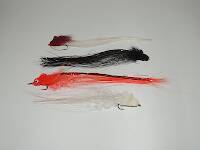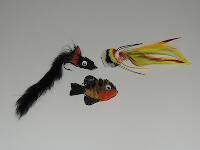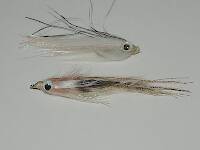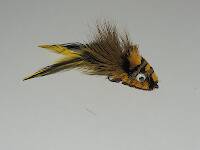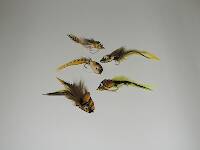
Salmonflies
Pteronarcys californica
The giant Salmonflies of the Western mountains are legendary for their proclivity to elicit consistent dry-fly action and ferocious strikes.
Featured on the forum

This one was surprisingly straightforward to identify. The lack of a sclerite at the base of the lateral hump narrows the field quite a bit, and the other options followed fairly obvious characteristics to Clostoeca, which only has one species, Clostoeca disjuncta.

Troutnut is a project started in 2003 by salmonid ecologist Jason "Troutnut" Neuswanger to help anglers and
fly tyers unabashedly embrace the entomological side of the sport. Learn more about Troutnut or
support the project for an enhanced experience here.
Chris_3g
Posts: 59
Posts: 59
Chris_3g on Jun 1, 2007June 1st, 2007, 4:50 am EDT
In a couple of weeks, I'm going to be heading to my hometown in southern Indiana where bass and bluegill abound in a lake near my parents house (I know, they aren't trout, but they are fun fish to catch!). Anyway, I just learned how to tie spun deer hair flies, and my question is this: can I use permanent markers (or paint or ???) to color the spun deer hair to make the colorful bass bugs I see everywhere on the internet? I just don't want to go out and purchase 20 bunches of deer hair, all of different colors, only to tie a multi-colored spun deer hair bass bug that looks NOTHING like it's supposed to. As always, thanks for any advice!
Chris.
Chris.
Troutnut on Jun 1, 2007June 1st, 2007, 5:02 am EDT
It's generally done with dyed deer hair. I'm sure you could accent things with markers and get some neat effects, but if you want the fly to look anything like it's "supposed to" you'll definitely need dyed hair. You just can't get the marker to color every side of every one of the round little hairs all the way down to the base.
Jason Neuswanger, Ph.D.
Troutnut and salmonid ecologist
Troutnut and salmonid ecologist
Shawnny3 on Jun 1, 2007June 1st, 2007, 11:33 am EDT
I agree with Jason - markers are way more pain than they're worth, and you'll probably be disappointed with the results. Deer and elk hair are kind of glossy and don't really take marker all that well for anything except, as Jason says, accents. Furthermore, markers tend to fade relatively quickly and your flies will start to lose their vibrance.
The good news is that you don't have to spend much money to get a bagful of deer or elk hair. Rather than buying normal-sized patches of many different colors and spending $20-$30 to outfit yourself in an array of colors, I would advise buying a combo pack of smaller patches (it doesn't sound like you're planning on tying tons of flies). For example, the following site sells a nice assortment of six small patches for a grand total of $4.05, about the cost of one well-tied Dahlberg Diver: Dalhberg Diver link here
By the way, once you've spun the hair the way you want it (and you have to spin it as thick and as tight as you possibly can for best results), don't trim it to shape with scissors. Instead, use one of those old flexible shaving blades, bend it to shape in your fingers, and you'll get magical results.
And one more word of warning - tying spun flies is fun, but the only messier job in the world is tarring your driveway.
Have fun,
Shawn
The good news is that you don't have to spend much money to get a bagful of deer or elk hair. Rather than buying normal-sized patches of many different colors and spending $20-$30 to outfit yourself in an array of colors, I would advise buying a combo pack of smaller patches (it doesn't sound like you're planning on tying tons of flies). For example, the following site sells a nice assortment of six small patches for a grand total of $4.05, about the cost of one well-tied Dahlberg Diver: Dalhberg Diver link here
By the way, once you've spun the hair the way you want it (and you have to spin it as thick and as tight as you possibly can for best results), don't trim it to shape with scissors. Instead, use one of those old flexible shaving blades, bend it to shape in your fingers, and you'll get magical results.
And one more word of warning - tying spun flies is fun, but the only messier job in the world is tarring your driveway.
Have fun,
Shawn
Jewelry-Quality Artistic Salmon Flies, by Shawn Davis
www.davisflydesigns.com
www.davisflydesigns.com
Teacherprea on Jun 2, 2007June 2nd, 2007, 10:03 am EDT
Been tying deer hair, "Jack Frogs" as we call them, for over 50 years. Learned from my Dad when I was about ten years old. I live in NW Indiana and fish all over Michigan, but love Da UP. I have tied all colors but feel the color is more for the guy on the end of the fly rod more than the fish. Have caught hundreds of bass on Natural deer hair. To get started just use natural deer hair color and see what happens. You'll be surprised!!! I think we give fish way too much credit for their intellegence. After all they really haven't changed much in the last 1,000 years!!!!!!!!!!
Dick Gross
Hobart, IN
Hobart, IN
Konchu on Jun 2, 2007June 2nd, 2007, 3:41 pm EDT
A friend of mine once argued with an outfitter in a fly shop during a tying demo about color and flies. The outfitter was trying to sell his flies and going on and on about how important coloration is the fish. My friend made the point that you just did: color isn't all that important.
I wonder if any of the fisheries guys out there know anything about various fish and color vision. It might be the contrast that is more important than the subtle colors. But on the other hand, it is important to take pride in one's work. A beautiful fly is a work of art.
I hunt and fish in southern Indiana, too, not as much as I'd like, but I often save fur, feathers, etc.
I wonder if any of the fisheries guys out there know anything about various fish and color vision. It might be the contrast that is more important than the subtle colors. But on the other hand, it is important to take pride in one's work. A beautiful fly is a work of art.
I hunt and fish in southern Indiana, too, not as much as I'd like, but I often save fur, feathers, etc.
Invicta on Jun 2, 2007June 2nd, 2007, 3:48 pm EDT
Some years back Tim England had his deer hair creations published. Tim was quite an artist and used permanent markers to color several of the patterns; I particularly remember one called the ‘Magic Minnow’. It was colored on white deer hair to appear as a juvenile trout, and as he explained how he achieved the final result there was considerable blending of marker inks involved. While the ‘minnow’ looked awesome in a display case, making one took about 6 hours. Though it certainly impressed those who saw the pattern, I don’t think it ever impressed a fish. Stacking hair is the only way to achieve permanent multi-coloring of your bug. Its great fun and you can create some truly unique patterns. But you don’t need to do it to improve your chances of fishing success. Shape of the bug, size, cut of the face and how you fish it is more important.
You may not need them, but here are a couple of points that may help in tying deer hair patterns:
1) To obtain a dense hair body the most important factor is using enough hair. Typically, if I am spinning a hair bug, each clump of hair is equal to four #2 wooden pencils in size. Packing the hair is important, but that step is not what makes the hair dense. If you don't use enough hair you can use a hydraulic jack and it won't make the body dense. Most of the time anemic-looking bodies are caused by using too little hair. Be cautious that you don't try to use too much hair. There is a point of diminishing return in this process. Try to stay around four pencils in size and you should be OK.
2) Another point many tiers don't recognize is that the diameter of each hair is also a factor. I am able to achieve the densest body with medium-coarse hair vs. a super-coarse hair. I also use gel-spun thread, between 100 and 130 denier, this allows me to put maximum pressure without cutting the hair. I currently use Gudebrod GX2 thread (130 denier) which has the strength, size, and suppleness to do hair bugs. For small hair bugs use Wapsi 50 denier gel thread. You can also use polyester thread, I did for years, and it works great. Stay away form Kevlar thread, it is just too hard to work with and cuts the hair easily.
3) When you get to the point of trimming your deer hair creation single edged razor blades are about the best thing going, after a rough trimming with a good set of scissors. But before you cut with the razor blade, steam the rough cut hair for a few seconds. That steam will remove any crush and bending the hair may have suffered and swell the fibers tightly. When you then trim with the razor it will be like cutting on soft foam rather than hair.
4) Lastly, before you cut one hair spray you, your deer hair, working area and nearby floor with static-guard. You’ll really appreciate doing this when you clean up.
Lets us know how it all works out!
John
You may not need them, but here are a couple of points that may help in tying deer hair patterns:
1) To obtain a dense hair body the most important factor is using enough hair. Typically, if I am spinning a hair bug, each clump of hair is equal to four #2 wooden pencils in size. Packing the hair is important, but that step is not what makes the hair dense. If you don't use enough hair you can use a hydraulic jack and it won't make the body dense. Most of the time anemic-looking bodies are caused by using too little hair. Be cautious that you don't try to use too much hair. There is a point of diminishing return in this process. Try to stay around four pencils in size and you should be OK.
2) Another point many tiers don't recognize is that the diameter of each hair is also a factor. I am able to achieve the densest body with medium-coarse hair vs. a super-coarse hair. I also use gel-spun thread, between 100 and 130 denier, this allows me to put maximum pressure without cutting the hair. I currently use Gudebrod GX2 thread (130 denier) which has the strength, size, and suppleness to do hair bugs. For small hair bugs use Wapsi 50 denier gel thread. You can also use polyester thread, I did for years, and it works great. Stay away form Kevlar thread, it is just too hard to work with and cuts the hair easily.
3) When you get to the point of trimming your deer hair creation single edged razor blades are about the best thing going, after a rough trimming with a good set of scissors. But before you cut with the razor blade, steam the rough cut hair for a few seconds. That steam will remove any crush and bending the hair may have suffered and swell the fibers tightly. When you then trim with the razor it will be like cutting on soft foam rather than hair.
4) Lastly, before you cut one hair spray you, your deer hair, working area and nearby floor with static-guard. You’ll really appreciate doing this when you clean up.
Lets us know how it all works out!
John
Teacherprea on Jun 3, 2007June 3rd, 2007, 2:04 am EDT
Konchu,I agree, a well tied fly IS a work of art.I have put eyes on hair frogs, used many colors, (and I'm color blind)and agree with what you say. It is alot of fun experimenting with color and style. But these days when I fish bass I usually look in the box and think to myself. "Let's see, this one looks good today!" and tie it on! (:
Dick Gross
Hobart, IN
Hobart, IN
Shawnny3 on Jun 3, 2007June 3rd, 2007, 10:34 am EDT
Nice tips, John. I'll have to try a few of those the next time I spin some hair.
-Shawn
-Shawn
Jewelry-Quality Artistic Salmon Flies, by Shawn Davis
www.davisflydesigns.com
www.davisflydesigns.com
Invicta on Jun 3, 2007June 3rd, 2007, 2:29 pm EDT
Thanks Shawn,
I owe my insight to having made a considerable number of mistakes in my earlier years, that were since corrected by my paying attention to advice given by a couple of friends…Jimmy Nix and Poul Jorgensen. It never hurts to pass it forward…
John
I owe my insight to having made a considerable number of mistakes in my earlier years, that were since corrected by my paying attention to advice given by a couple of friends…Jimmy Nix and Poul Jorgensen. It never hurts to pass it forward…
John
Chris_3g
Posts: 59
Posts: 59
Chris_3g on Jun 7, 2007June 7th, 2007, 4:46 pm EDT
Hey everyone. I just realized I hadn't thanked you all for your words of wisdom on the topic, so thanks to all who posted!
Chris.
Chris.
Clyde on Oct 31, 2007October 31st, 2007, 4:06 am EDT
Deer hair is fun and easy to work with. There are many great fly patterns and most of us innovate also. You can even leave the deer hair "long or full" in the belly area of your fly to form a natural "weed guard!" Most fish suck in the fly --then they crush it in their mouth to kill it or immobilize the prey --then they swallow it. So, this deer hair "weed guard" works well -- unless you set the hook to soon.
The debate rages! Color, size, action, sound, vibration, speed, depth, etc. All I know is sometimes the fish will take anything, any color, etc. Then, [and most of the time] these things matter -- and figuring out which one matters on this particuliar day, time, water clarity, etc. --makes fishing so much fun! Otherwise we would catch 100's / day and soon it would be like harvesting wheat --just go on the water and load 'em up! Otherwise, there would be only ONE LURE, ONE FLY --and that is all you need --so the Bass Pro Shops, Cabela's and every little bait shop would be out of business and we wouldn't be having this discussion!
So, we keep on trying to create the perfect Fly, bug, lure, and they all work, to some degree! Even "mistakes" and "ugly" flies and "gaudy" plugs and lures will catch fish--on occasion.
The amazing thing is, Fish seem to be hungry all the time. They will even strike an easy meal presented to them -- even with a full stomach! And then, at other times --Lock jaw!
Keep your line wet.
In His Love,
Clyde
The debate rages! Color, size, action, sound, vibration, speed, depth, etc. All I know is sometimes the fish will take anything, any color, etc. Then, [and most of the time] these things matter -- and figuring out which one matters on this particuliar day, time, water clarity, etc. --makes fishing so much fun! Otherwise we would catch 100's / day and soon it would be like harvesting wheat --just go on the water and load 'em up! Otherwise, there would be only ONE LURE, ONE FLY --and that is all you need --so the Bass Pro Shops, Cabela's and every little bait shop would be out of business and we wouldn't be having this discussion!
So, we keep on trying to create the perfect Fly, bug, lure, and they all work, to some degree! Even "mistakes" and "ugly" flies and "gaudy" plugs and lures will catch fish--on occasion.
The amazing thing is, Fish seem to be hungry all the time. They will even strike an easy meal presented to them -- even with a full stomach! And then, at other times --Lock jaw!
Keep your line wet.
In His Love,
Clyde
KEEP YOUR LINE WET
In His Love,
Clyde
In His Love,
Clyde
Falsifly on Oct 31, 2007October 31st, 2007, 6:57 am EDT
In response to Konchu’s question about color vision.
In their book “Understanding Trout Behavior” authors John Goddard and Brian Clarke state that freshwater fish including trout can distinguish between different colors and even sensitivity of color. They point to a study conducted by Professor W.R.A. Muntz Dept of Biology at Sterling University and others. It seems that in experiments fish have been trained to respond to color and are even quick learners.
In their book “Understanding Trout Behavior” authors John Goddard and Brian Clarke state that freshwater fish including trout can distinguish between different colors and even sensitivity of color. They point to a study conducted by Professor W.R.A. Muntz Dept of Biology at Sterling University and others. It seems that in experiments fish have been trained to respond to color and are even quick learners.
Falsifly
When asked what I just caught that monster on I showed him. He put on his magnifiers and said, "I can't believe they can see that."
When asked what I just caught that monster on I showed him. He put on his magnifiers and said, "I can't believe they can see that."
Konchu on Nov 2, 2007November 2nd, 2007, 1:32 pm EDT
Thanks, Falsifly. In a few days, I'll see if I can track down that primary reference and go from there. Cheers!
Falsifly on Nov 3, 2007November 3rd, 2007, 4:18 am EDT
2001 The Lyons Press ISBN 1-58574-300-3.
www.lyonspress.com
I believe I picked up my copy as a freebie some years ago renewing my TU membership. It is one of the most comprehensive works on the what how and why of the trouts vision that I have read. All in layman terms.
www.lyonspress.com
I believe I picked up my copy as a freebie some years ago renewing my TU membership. It is one of the most comprehensive works on the what how and why of the trouts vision that I have read. All in layman terms.
Falsifly
When asked what I just caught that monster on I showed him. He put on his magnifiers and said, "I can't believe they can see that."
When asked what I just caught that monster on I showed him. He put on his magnifiers and said, "I can't believe they can see that."
Jmd123 on Nov 6, 2007November 6th, 2007, 1:41 pm EST
I have one simple observation to make, folks. If fish can't see in color, then why are fish COLORFUL? The fact that many if not most fish species are distiguished by their unique combination of colors means that the fish themselves must be able to see them, in order to distinguish members of their own species for mating. Otherwise, they might mate with other species, which may or may not be fertile and thus could potentially waste a fish's reproductive potential.
That's not to mention the fact that fly-tying materials come in EVERY COLOR of the rainbow, and I don't think that's accidental nor just for the eyes of the fisherman.
The natural deer hair colors that Dick is using are probably close enough to imitate some of his local food organisms (frogs and big insects). Or, perhaps in the waters he is fishing, shape and motion are more important than actual color. However, a different color may be what's needed in some cases to get a sluggish fish to take interest and strike...
Tight lines and a few more bass before the ponds freeze over!
Jonathon
That's not to mention the fact that fly-tying materials come in EVERY COLOR of the rainbow, and I don't think that's accidental nor just for the eyes of the fisherman.
The natural deer hair colors that Dick is using are probably close enough to imitate some of his local food organisms (frogs and big insects). Or, perhaps in the waters he is fishing, shape and motion are more important than actual color. However, a different color may be what's needed in some cases to get a sluggish fish to take interest and strike...
Tight lines and a few more bass before the ponds freeze over!
Jonathon
No matter how big the one you just caught is, there's always a bigger one out there somewhere...
Konchu on Nov 7, 2007November 7th, 2007, 4:12 am EST
I think the olfactory senses (smell/taste) probably play more of a role in recognition for reproduction than sight, but I could be wrong.
Jmd123 on Nov 7, 2007November 7th, 2007, 9:06 am EST
I don't think so many fish would be SO colorful if there wasn't somne evolutionary advantage to it. Otherwise, ALL fish would be dull shades of green, brown, gray, or blue, depending on the background for camouflage. And it is well known that the males of many fish species will intensify in color during the breeding season, perhaps as a way to show fitness to prospective females (the brighter the colors, the better the genes...). If they can, and obviously DO, see these colors, I wouldn't doubt that trout use it to their advantage to key in on hatching insects, if simply to make feeding more efficient. Of course, at other times, form, motion, or sound may take the place of colors as feeding stimuli - perhaps in Dick's bass pond, for example.
The evolutionary biologist in me doesn't accept that things aren't the way they are in the natural world for no reason. Survival of the fittest to reproduce comes in many forms - in one fish, it might be how well the colors match the background, whereas for another species, how bright the colors are determines who gets to mate the most.
Yes, I am a firm believer in the theory of evolution. Some may care to argue with me, but I think the only reason that evolution is not a FACT is simply because we can't go back 3 billion years in time to watch it all happen.
Jonathon
The evolutionary biologist in me doesn't accept that things aren't the way they are in the natural world for no reason. Survival of the fittest to reproduce comes in many forms - in one fish, it might be how well the colors match the background, whereas for another species, how bright the colors are determines who gets to mate the most.
Yes, I am a firm believer in the theory of evolution. Some may care to argue with me, but I think the only reason that evolution is not a FACT is simply because we can't go back 3 billion years in time to watch it all happen.
Jonathon
No matter how big the one you just caught is, there's always a bigger one out there somewhere...
Shawnny3 on Nov 7, 2007November 7th, 2007, 9:32 am EST
The evolutionary biologist in me doesn't accept that things aren't the way they are in the natural world for no reason.
Actually, I would think that the evolutionary biologist would precisely REQUIRE that things are the way they are for no reason. On the contrary, I was under the impression that it's the Intelligent Design folk who believe that reason has something to do with it. Perhaps the extremes are not so different from one another after all - what a happy world we live in.
Or am I just conflating two distinct meanings of the same term?
-Shawn
Jewelry-Quality Artistic Salmon Flies, by Shawn Davis
www.davisflydesigns.com
www.davisflydesigns.com
Jmd123 on Nov 7, 2007November 7th, 2007, 2:51 pm EST
Shawn, my use of the word "reason" has ABSOLUTELY NOTHING to do with creationism or any other so-called alternative to modern science. What I am saying is that there is a REASON that fish are colorful, that has nothing to do with any supreme being or whatever. The REASON is that it helps fish survive! If it didn't, colorful fish would be killed off at a young age and, like I said, all fish would be some subdued color to hide from predators (and ambush prey).
So, why is the sky blue? Well, there's a REASON for that too - it's because the combination of gasses that make up our atmosphere happen to scatter "blue" photons (defined by wavelength) and absorb those of other colors (i.e., wavelengths). Blue wavelengths just happen to fall within our visual range, so that's why the sky is blue, at least to us humans.
So, why do humans happen to see a blue sky? Perhaps the color assignment is random - other creatures can see either farther into the infrared or the ultraviolet. Hey, it's whatever has worked in the long run that has helped survival. Perhaps humans can see blue skies because, in the long run, it helped them to predict when bad weather was coming (e.g., the sky isn't blue but dark grey, there's bad weather coming) and therefore survive.
Shawn, you may be confusing reason with purpose. Evolutionary biology has ABSOLUTELY NOTHING to do with purpose. I've had people ask me, "What is the purpose of mosquitos?" In evolutionary biology, there IS NO purpose. However, there is opportunity, and that's how evolution works. Hey, if mosquitos can make a living sucking blood from mammals and other vertebrates, by golly, they're gonna do it! Why? Not out of any purpose, but here is a set of resources - nice, protein-rich blood - that's pretty much open for exploitation, and, given that, SOMETHING is going to find a way to take advantage of that. Some ancestor of the mosquito was born with a different set of mouthparts than the species it's "supposed" to be, due to a random mutation (they happen all the time, but only about 0.00001 percent are advantageous for survival, the rest will kill you). Well, said insect discovers that it can pierce mammalian skin and extract a fluid that is loaded with protein, and the increased nutrition allows this insect to create more offspring than the other members of its species. A few generations of this and the new insect is proliferating at a faster rate than its parent species, and pretty soon you have the makings of the modern mosquito. Is there a purpose in there somewhere? I don't see it. Is there an opportunity in there? HELL YES!!!!!!
Please, no more arguments about evolution vs. religion, folks! I'm getting tired of this. Can't we just talk about fishing???
Jonathon
So, why is the sky blue? Well, there's a REASON for that too - it's because the combination of gasses that make up our atmosphere happen to scatter "blue" photons (defined by wavelength) and absorb those of other colors (i.e., wavelengths). Blue wavelengths just happen to fall within our visual range, so that's why the sky is blue, at least to us humans.
So, why do humans happen to see a blue sky? Perhaps the color assignment is random - other creatures can see either farther into the infrared or the ultraviolet. Hey, it's whatever has worked in the long run that has helped survival. Perhaps humans can see blue skies because, in the long run, it helped them to predict when bad weather was coming (e.g., the sky isn't blue but dark grey, there's bad weather coming) and therefore survive.
Shawn, you may be confusing reason with purpose. Evolutionary biology has ABSOLUTELY NOTHING to do with purpose. I've had people ask me, "What is the purpose of mosquitos?" In evolutionary biology, there IS NO purpose. However, there is opportunity, and that's how evolution works. Hey, if mosquitos can make a living sucking blood from mammals and other vertebrates, by golly, they're gonna do it! Why? Not out of any purpose, but here is a set of resources - nice, protein-rich blood - that's pretty much open for exploitation, and, given that, SOMETHING is going to find a way to take advantage of that. Some ancestor of the mosquito was born with a different set of mouthparts than the species it's "supposed" to be, due to a random mutation (they happen all the time, but only about 0.00001 percent are advantageous for survival, the rest will kill you). Well, said insect discovers that it can pierce mammalian skin and extract a fluid that is loaded with protein, and the increased nutrition allows this insect to create more offspring than the other members of its species. A few generations of this and the new insect is proliferating at a faster rate than its parent species, and pretty soon you have the makings of the modern mosquito. Is there a purpose in there somewhere? I don't see it. Is there an opportunity in there? HELL YES!!!!!!
Please, no more arguments about evolution vs. religion, folks! I'm getting tired of this. Can't we just talk about fishing???
Jonathon
No matter how big the one you just caught is, there's always a bigger one out there somewhere...
Falsifly on Nov 7, 2007November 7th, 2007, 6:25 pm EST
Evolution: A gradual process in which something changes into a different and more complex or better form.
Religion: A cause, principle, or activity pursued with zeal or conscientious devotion.
Sounds like fishing to me.
Religion: A cause, principle, or activity pursued with zeal or conscientious devotion.
Sounds like fishing to me.
Falsifly
When asked what I just caught that monster on I showed him. He put on his magnifiers and said, "I can't believe they can see that."
When asked what I just caught that monster on I showed him. He put on his magnifiers and said, "I can't believe they can see that."
Quick Reply
Related Discussions
Topic
Replies
Last Reply







